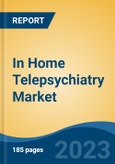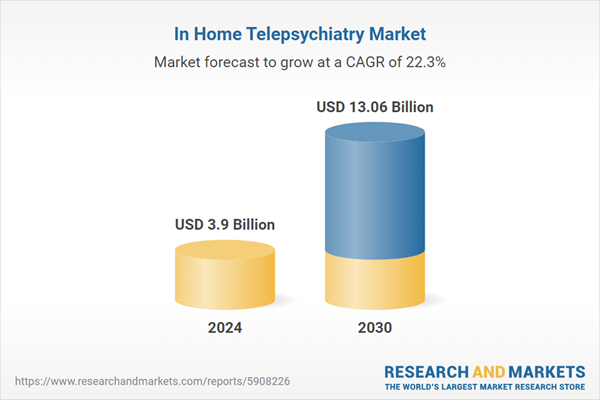Speak directly to the analyst to clarify any post sales queries you may have.
10% Free customizationThis report comes with 10% free customization, enabling you to add data that meets your specific business needs.
In-Home Telepsychiatry refers to the remote delivery of psychiatric services, including assessment, diagnosis, therapy, and medication management, using telecommunications technology. It enables mental health professionals to connect with patients virtually, delivering care in the comfort and privacy of patients' homes.
Key Market Drivers
Rising Prevalence of Mental Health Disorders and Growing Acceptance of Telehealth & Digital Psychiatry
The increasing prevalence of mental health disorders is a significant driver of the Global In-Home Telepsychiatry Market. As mental health conditions such as anxiety, depression, bipolar disorder, schizophrenia, and post-traumatic stress disorder (PTSD) continue to affect millions worldwide, there is a growing demand for accessible, affordable, and convenient psychiatric care.Telepsychiatry is emerging as a scalable and efficient solution, bridging the gap between demand and available mental health services. Approximately 1 in 4 of the global population will experience a mental or neurological disorder at some stage in their lives. Currently, an estimated 450 million individuals are living with such conditions, positioning mental health disorders among the primary drivers of healthcare burden and disability worldwide. This growing prevalence underscores the urgent need for scalable, accessible, and cost-effective psychiatric care solutions, creating significant opportunities for innovation and investment in telepsychiatry and digital mental health services.
Historically, mental health was often stigmatized, leading to underreporting and reluctance to seek treatment. However, awareness campaigns, advocacy groups, and social media have played a crucial role in reducing the stigma associated with psychiatric disorders. Depression has emerged as a leading cause of disability worldwide, disproportionately affecting 1 in 3 women and 1 in 5 men across diverse backgrounds. The condition has reached unprecedented levels in the U.S., where 18% of adults and 25% of individuals under 30 report experiencing depression or undergoing treatment.
If left undiagnosed or untreated, depression can escalate, with severe cases contributing to suicide - now responsible for over 700,000 deaths annually. These alarming statistics underscore the urgent need for expanded mental health resources, early intervention strategies, and greater societal awareness to address the growing burden of depression. High-profile individuals openly discussing their mental health struggles have encouraged more people to seek help. Employers and policymakers are now prioritizing mental health, further driving demand for professional psychiatric services.
With greater awareness, more individuals are actively seeking treatment, fueling the adoption of telepsychiatry services that provide confidential and discreet care in a home setting. The growing prevalence of mental health conditions has overburdened traditional healthcare systems, leading to: Long waiting times for psychiatric appointments, Limited access to mental health specialists, especially in rural or underserved areas, Financial barriers, as in-person therapy and hospital visits can be expensive. This increased accessibility and affordability make telepsychiatry an attractive solution for individuals struggling with mental health disorders.
Key Market Challenges
Regulatory and Licensing Complexities
Telepsychiatry providers often encounter challenges related to varying state-by-state regulations in the United States. Each state has its own licensing requirements and regulations governing telehealth services. Complying with this patchwork of regulations can be complex and costly for providers.For telepsychiatry services that extend beyond national borders, navigating international regulations and licensing requirements can be even more challenging. Differences in healthcare laws and standards can hinder the expansion of services to a global audience. Telepsychiatry providers must adhere to strict patient privacy regulations, such as HIPAA in the United States. Ensuring the security and confidentiality of patient data across digital platforms adds another layer of complexity and potential liability.
Key Market Trends
Integration of Artificial Intelligence (AI) and Machine Learning (ML)
AI and ML algorithms analyze patient data, including mental health histories, treatment responses, and even biometric data. This allows for the creation of highly personalized treatment plans tailored to each individual's unique needs.AI can identify subtle changes in patient behavior or symptoms, facilitating early intervention in mental health crises. This proactive approach can prevent the escalation of mental health issues and improve patient outcomes. AI-powered diagnostic tools can enhance the accuracy of mental health assessments by analyzing speech patterns, facial expressions, and other non-verbal cues during telepsychiatry sessions. This can lead to more precise diagnoses and treatment recommendations.
Key Market Players
- Array Behavioral Care
- innovate LLC
- Advanced Telemed Services
- American TelePsychiatry
- Telemynd Inc
- Encounter Telehealth
- Genoa Telepsychiatry
- American Well Corp
- Ieso Digital Health Ltd.
- American Telepsychiatrists
Report Scope:
In this report, the Global In Home Telepsychiatry Market has been segmented into the following categories, in addition to the industry trends which have also been detailed below:In Home Telepsychiatry Market, By Type:
- Software
- Devices
In Home Telepsychiatry Market, By Age Group:
- Adult
- Pediatric & Adolescent
- Geriatric
In Home Telepsychiatry Market, By Application:
- Psychiatric Evaluations and Diagnoses
- Therapy
- Medication Management
In Home Telepsychiatry Market, By Region:
- North America
- United States
- Canada
- Mexico
- Europe
- France
- United Kingdom
- Italy
- Germany
- Spain
- Asia-Pacific
- China
- India
- Japan
- Australia
- South Korea
- South America
- Brazil
- Argentina
- Colombia
- Middle East & Africa
- South Africa
- Saudi Arabia
- UAE
Competitive Landscape
Company Profiles: Detailed analysis of the major companies present in the Global In Home Telepsychiatry Market.Available Customizations:
With the given market data, the publisher offers customizations according to a company's specific needs. The following customization options are available for the report.Company Information
- Detailed analysis and profiling of additional market players (up to five).
This product will be delivered within 1-3 business days.
Table of Contents
Companies Mentioned
- Array Behavioral Care
- innovate LLC
- Advanced Telemed Services
- American TelePsychiatry
- Telemynd Inc
- Encounter Telehealth
- Genoa Telepsychiatry
- American Well Corp
- Ieso Digital Health Ltd.
- American Telepsychiatrists
Table Information
| Report Attribute | Details |
|---|---|
| No. of Pages | 185 |
| Published | February 2025 |
| Forecast Period | 2024 - 2030 |
| Estimated Market Value ( USD | $ 3.9 Billion |
| Forecasted Market Value ( USD | $ 13.06 Billion |
| Compound Annual Growth Rate | 22.2% |
| Regions Covered | Global |
| No. of Companies Mentioned | 10 |









